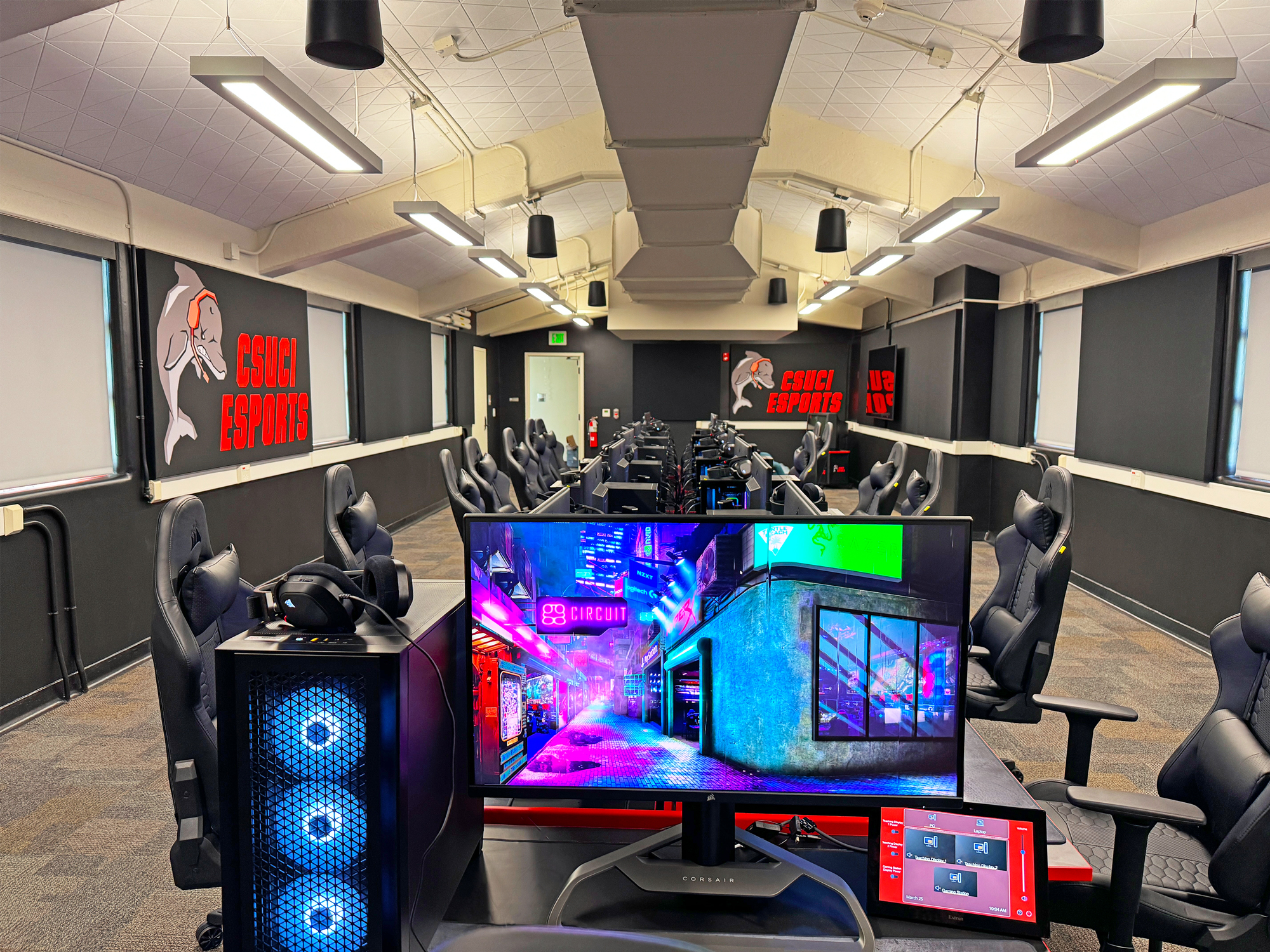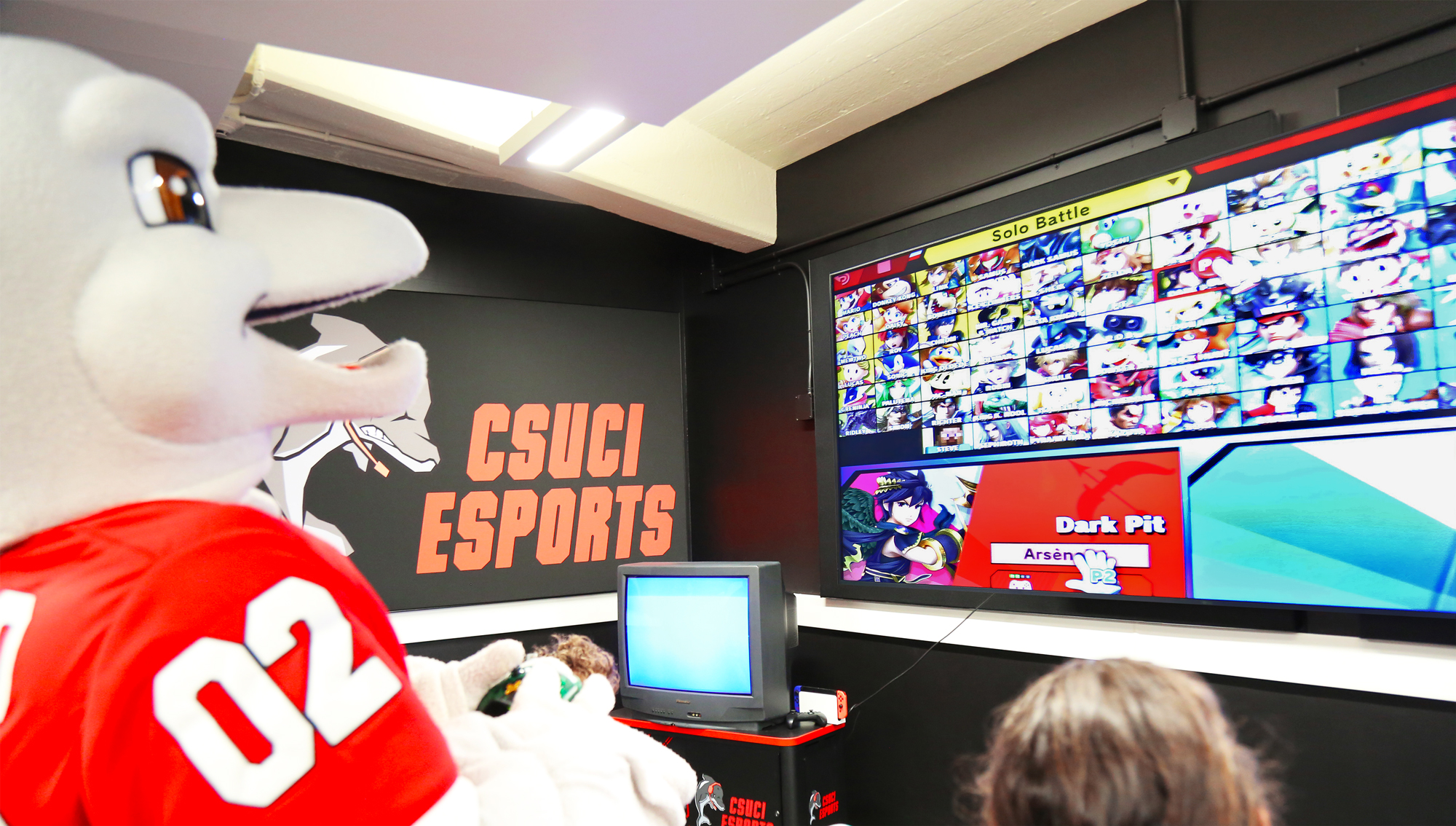Opened in 2002, California State University Channel Islands (CSUCI) occupies a picturesque campus nestled against the Santa Monica Mountain foothills. The Dolphins esports club has been active on the CSUCI campus for some time, using improvised quarters in classrooms and, occasionally, even overflowing into hallways.
A student-driven initiative, supported by the administration, led to the recent opening of a purpose-built esports lounge equipped with sophisticated computer, network, and audiovisual technology that can support the ultimate goal of competing in intercollegiate esports league tournaments. The new venue allows the esports club to fulfill its charter to promote a friendly gaming community that encourages student comradery while building computer literacy and providing a social outlet through video games. A robust esports program is also a draw for student recruitment, particularly to encourage on-campus residency.
Christopher Murphy, CSUCI’s Information Technology Services (ITS) manager of User Services, his IT team, and esports team members turned the esports lounge vision into reality. They did it with assistance from pro integrator EKC Enterprises, headquartered in Fresno, California, who performed design, installation, and AV control programming. Student members of the esports club contributed to the effort by building many of the high-performance gaming PCs at build parties facilitated by the ITS department. Extron products play key roles in AV signal switching, distribution, control, and audio. NAV Pro AV over IP provides the flexible and scalable AV distribution backbone.
“Extron listened to our needs,” Murphy said. “They presented a CrossPoint switch solution and a NAV Pro AV-over-IP solution. They walked us through the pros and cons of both designs for our esports application, looking at technical and cost tradeoffs and flexibility. It was really helpful having that expertise at hand.” He continued, “As an IT manager, one of the first things to come to mind when we selected NAV for the esports lounge was compatibility with our existing network switches. By the time design was complete and installation began, Extron had certified our network switches for NAV compliance.”

Setting Up for Success

Fourteen gaming stations occupy a long table, with seven stations on each side. The instructor gaming station is at the head of the table. Each station includes a high-performance gaming PC running gaming software apps, a high-refresh-rate gaming monitor, a gaming keyboard, a mouse, and headphones. The gaming monitors connect to the PCs via DisplayPort.
For intramural gameplay between the 15 stations in the room, the gaming apps running on the PCs interact over the Ethernet LAN. Via this LAN connection, the instructor station operator can select and observe the gameplay action being viewed and heard at any of the 15 stations. The play action being observed at the instructor station is available at the HDMI port of the instructor's PC. This port is connected to the AV-over-IP network via a NAV E 101 encoder. The selected gaming action is routed through the AV-over-IP network to any of the room’s three spectator screens and to the overhead pendant speakers for the audience to take in.
“Similar to our campus’s classroom AV systems, the esports AV system is on a VLAN within our campus enterprise network,” Murphy explained. “With the esports lounge in daily use, the network has functioned normally. I’ve seen no impacts to AV signal transmission nor to the gaming experience. And overall network performance remains solid.”
The instructor station includes a second NAV encoder to accommodate the connection of a laptop PC to the AV-over-IP network. The laptop can be used as a 16th gaming station, or it can provide lecture content for conducting traditional class instruction in the room.
The room has three commercial-grade 4K UHD digital signage displays. Two 75-inch displays are on the wall at the instructor's end of the gaming station table. In the main spectator viewing area located behind the instructor station, guests can watch the action while sitting on couches that face an 86-inch display. Mounted behind each display is a NAV SD 101 scaling decoder connected to the AV-over-IP network. Each decoder provides its display with an HDMI signal carrying the gameplay action and RS-232 signals to control the display.
Spectators in the room get high-fidelity sound through six SF 26PT ceiling-mounted pendant speakers. The speakers are driven by a powerful yet energy-efficient XPA U 1004 amplifier with four 100W channels. Ahead of the amplifier is a DMP 128 Plus audio DSP processor that interfaces the audio system to the AV-over-IP network via Dante/AES67 connectivity. The DMP unit tailors the audio for room acoustics and provides AEC audio echo cancellation.
System Control and Scheduling
The AV system is controlled by an IPCP Pro xi control processor. A NAVigator system manager configures and manages the endpoints of the NAV AV-over-IP network.
The user interface is a 10-inch tabletop TouchLink Pro touchpanel positioned at the instructor station. Using Global Configurator Plus and GUI Designer, EKC Enterprises created an intuitive user interface for the touchpanel that allows the operator to send gaming action from any one of the gaming stations to any of the spectator screens in the room. The two 75-inch displays on the front wall of the room double as teaching displays when the esports lounge is functioning as a standard classroom, receiving audiovisual lecture material from the instructor station desktop or laptop PC.
CSUCI expects the esports lounge to be in high demand for both gaming and teaching. So they decided to include the lounge as a bookable room in the CSU 25Live Pro room scheduling system. At the entrance to the esports lounge, a 10-inch TLS room scheduling touchpanel shows booking details for the room and indicates at a glance with green or red backlighting, depending on whether the room is occupied. The scheduling panel is connected to the 25Live scheduling system via Room Agent room booking software, so the room can be reserved right from the touchpanel, from a computer, a smartphone, or tablet.

A Future-Minded Solution
Designs have already been mapped out to expand AV system functionality in the esports lounge. The scalability of the NAV Pro AV-over-IP network makes incremental future additions to the AV system straightforward. Adding each new endpoint requires only an additional NAV encoder or scaling decoder.
The AV system design includes provisions for the installation of SMP 111 and SMP 352 streaming media processors to add recording and streaming functionality. This will enable the CSUCI Dolphins esports team to compete in intercollegiate league tournaments via internet gaming platforms such as Twitch. In the same vein, the design accommodates the addition of a Mediaport 300 scaling bridge, which sends audio and video signals from the AV system to the instructor's PC for integration with software and cloud-based unified communication platforms such as Zoom. PTZ cameras are also a planned addition to provide video feeds of activities in the esports lounge for viewing, recording, and streaming.
To enhance the spectator experience, an MGP 641 xi multi-window processor is included in the design plan. This will provide the capability for the spectator displays to show up to four source signals on a single screen, with the windows arranged in any position and orientation against a live or static background.
Going forward, student clubs and university administrators will oversee event programming and upkeep of the facility. According to Dr. Eboni Ford Turnbow, vice president for Student Affairs and a key advocate for the esports lounge, her office plans to expand tournament participation and partnerships within the national academic community and the local Ventura County community. Also, faculty will be encouraged to take advantage of the technology-rich environment for teaching uses.
“Everyone involved in designing and installing the esports lounge network and AV systems came together and communicated well,” Murphy said. “CSUCI’s network team talked with Extron and learned everything they needed to do. Extron quickly diagnosed and resolved the few network issues that popped up during integration. Everything came together on the planned schedule. Everything
worked great.”
[Extron Enables Seamless Switching for Southern California Esports Program]
